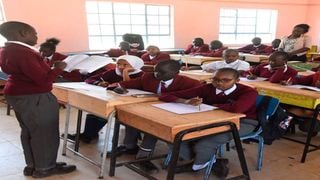
A teacher with Junior Secondary School students during a lesson at Eldo-Baraka School in Eldoret town, Uasin Gishu County.
Counties
Premium
How counties will share Sh3bn junior secondary schools funds
What you need to know:
- Kakamega County with 12 constituencies will receive Sh178 million, Nairobi will get Sh148 million, Bungoma Sh164 million, Nakuru Sh151 million and Kisii will get Sh120.78 million.
- The National Treasury allocated Sh3.4 billion for the construction of classrooms and integrated learning resource centres within the Junior Secondary Schools.
Kakamega, Bungoma, Nairobi, Nakuru, Kisii and Kilifi counties will get the lion’s share of the Sh3 billion allocated to the Ministry of Education for the development of infrastructure in Junior Secondary Schools (JSS).
According to the allocation schedule tabled by the National Assembly Committee on Education, Kakamega County with 12 constituencies will receive Sh178 million, Nairobi will get Sh148 million, Bungoma Sh164 million, Nakuru Sh151 million and Kisii will get Sh120.78 million.
Other counties that will also receive high allocations include Kilifi, which will receive Sh118 million, Homa Bay (Sh115,688,433), Kiambu (Sh114,162,733), Kitui (Sh112,286,633), Migori (Sh111,476,333), Kisumu (Sh107,151,083), Machakos (Sh106,019,583), Meru (Sh105,902,783) and Siaya (Sh105,161,833).
According to the Ministry of Education, different constituencies have been allocated varying amounts depending on Grade Seven enrolment.
In the current Financial Year, the National Treasury allocated Sh3.4 billion for the construction of classrooms and integrated learning resource centres within the Junior Secondary Schools.
The amount is a conditional grant and it is proposed to be jointly managed by the Ministry of Education and the National Government Constituency Development Fund (NG-CDF) to ensure synergy and timelines in implementing the programmes.
National Assembly Education Committee chairman Julius Melly told MPs that the allocations are based on Grade Seven enrolment and each constituency will match a shilling for a shilling.
“As a requirement, the 2023/2024 constituency proposals must have ministry of education input approved by the board. In addition, as a further requirement, NG-CDFs must incorporate sub county directors of education and deputy county commissioners in identifying schools and in implementation of the projects,” Mr Melly said.
A letter by Education Principal Secretary Belio Kipsang to the Chief Executive Officer of NG-CDF Yusuf Mbuno states that the CDF board and the ministry of education should coordinate on the identified projects.
“Following consultations within the Executive, this amount is proposed to be jointly managed by the ministry of education and the National Government Constituency Development Fund as a conditional grant,” Dr Kipsang said.
Since the introduction of the Competency Based Curriculum (CBC) MPs have been complaining that there is no infrastructure in the Junior Secondary Schools forcing them to dip their hands in the CDF to support most schools and parents who cannot afford school fees for their grade seven children.
The lawmakers have been pushing for the increased allocation of the amount allocated to bursaries in the CDF from the current 35 percent to 40 percent in order to cater for students in the JSS whom they said have been ignored by the NG-CDF board which only prioritise those in secondary schools, Universities and colleges.





